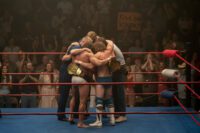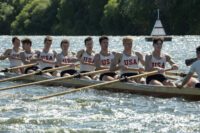Jaws: The Revenge isn’t a movie that filmmakers typically turn to for inspiration. This franchise-killing installment followed the all-too-common tendency for sequels to chew up the legacy of their better predecessors. At best, the fourth Jaws left copious warnings—here there be failures. Yet, despite the movie’s myriad missteps, the opening deserves consideration, particularly for anyone planning a creature feature.
The opening to Jaws: The Revenge puts the sequel on solid ground. Audiences are quickly reintroduced to the remains of the Brody family, specifically widowed Ellen along with her sons Sean and Michael. Their relationships are rosy, a fact confirmed solely by the ease of their mirthful interactions with one another. Basically, this is a loving family. It would certainly be a shame if something happened to one of them.
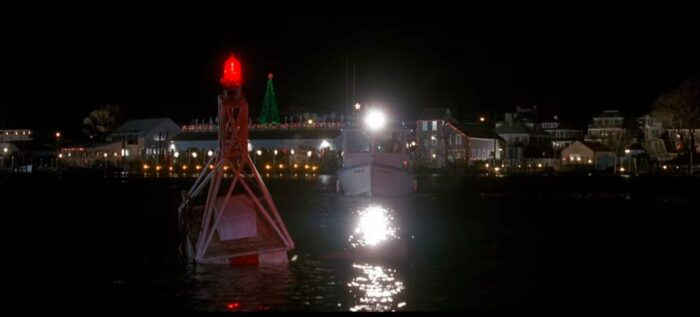
A police boat approaches a buoy in Jaws: The Revenge, © 1987 Universal Pictures. Screen capture courtesy Netflix.Visual storytelling is simple yet informative. Viewers see Sean, played by Mitchell Anderson, in a deputy’s uniform, so it makes sense that his character goes to the Amity Island sheriff station. There he receives word a loose piling has drifted away, lodging itself on a buoy. It needs to be cleared before various boats return that evening, so the dutiful deputy sails off. With him on the water, audiences anxiously anticipate horrific calamity.
Not far from shore, the sounds of a Christmas choir still audible, he begins to get at the log. The camera shifts to the shark’s perspective as it charges forward. In a furious montage of snapping teeth and screams, Sean’s arm is bitten off. As he begins hollering for help, his cries drowned out by distance and Christmas-y choral music, the massive great white lunges out of the ocean. It tears the boat apart, ripping Sean over the side into the water. Desperately clinging to the log, the poor fellow futilely cries for help but is dragged under. Soon, all that remains is a chewed-up piling as crimson spreads across dark water.
Although there isn’t anything surprising about a shark attack in the fourth Jaws movie, the way events unfold is perfectly paced. It takes advantage of anticipation while nicely establishing a sense of loss surrounding the victim. Moreover, the attack happens so suddenly Sean doesn’t even realize his arm is missing for a few seconds. The audience notices before him and will quickly regard his subsequent screams as hopeless, making them all the more terrifying and tragic.
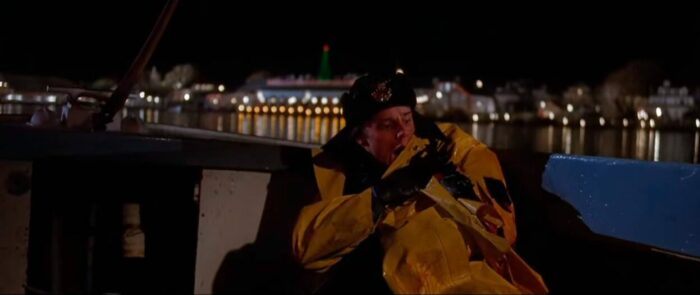
With horror sequels, certain surprises are unlikely. Viewers come in presuming details based on the previous films. In fact, the Jaws franchise belongs to a unique subset of the creature feature subgenre wherein the identity of the monster isn’t even a secret. Unlike films such as Alien, there’s little mystery surrounding the beast. That’s why what makes the opening to Jaws: The Revenge oddly good is the way it subtly informs about the monstrous shark.
As the movie unfolds, Lorraine Gary, who plays Ellen Brody, believes the great white is targeting her family for revenge. With that in mind, reflecting on the opening attack, it almost seems like a trap. It’s fair to assume the shark ripped off the piling and stuck it on the buoy. This implies a degree of intelligence which makes certain later instances of cat and mouse more sensible. Instead of attacking characters straight away, the main shark seems to toy with them. Such as the time it swims alongside Jake, played by Mario Van Peebles, instead of ripping into him outright.
Granted, the novelization penned by Hank Searls, offers other reasons for the great white’s attacks. The book version of Jaws: The Revenge claims the beast is the offspring of the first two sharks but is simply attracted to the area like any shark might because of the sound of the piling banging against the buoy. Attacking Sean is apparently a mere coincidence. Later, it follows Ellen to the Bahamas because of an angered voodoo priest who uses magic to attract the animal. I kind of wish filmmakers kept that subplot in; however, for reasons I can only presume are cowardice, they nixed the mystical angle to a degree.
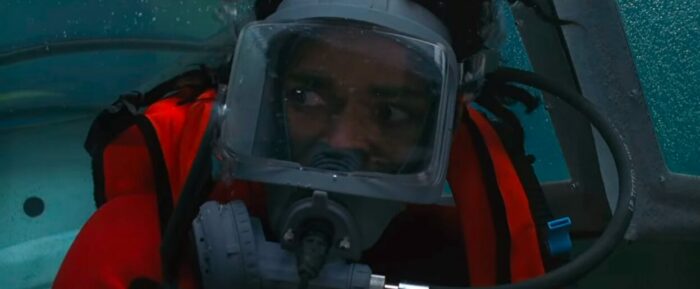
What remains in the final film, though, is the insinuation the great white is an intelligent animal out for revenge. The opening establishes this as well as the immense power of the beast. It effortlessly pulls Sean underwater along with the piling he’s clinging to. As such, within a few minutes, we have main characters established, the new nature of the beast, intelligent and vengeful, as well as a gruesome beginning promising more blood to come.
The first Jaws contained similarly subtle build-ups. Consider the scene investigating Ben Gardner’s boat. Most fans mainly remember this moment because of the gruesome corpse with its bulging eye. However, that scene also establishes the shark can take down a boat which means when Quint, Brody, and Hooper go out on the Orca later, the audience knows they aren’t safe.
What Jaws: The Revenge does well in the beginning is create expectations. Even create features which teased the nature of their respective monsters do so best when they trickle out implications about the beast. Tremors is easily the best example of this with each discovery of dead bodies suggesting more and more until the ultimate reveal. The 2012 Irish horror comedy Grabbers followed those tracks to similar success. Even the first Godzilla from 1954 starts with implications of the monster through the sinking of ships and loss of fish rather than outright showing the titular kaiju.
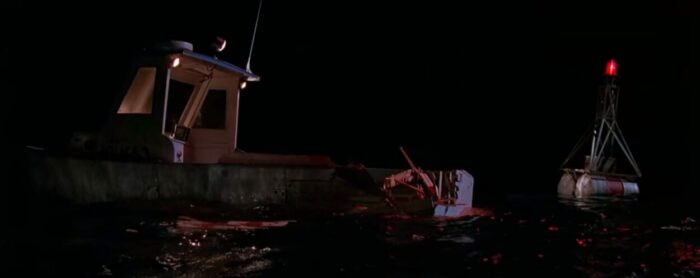
As such, take the iconic shark out of the picture. If we cut the montage footage that explicitly shows a great white and disregard the opening as a sequel, it’s easy to see how Jaws: The Revenge opens with a terrifying implication of a sea monster. And it doesn’t take much since it mimics the minimalistic approach of the first Jaws. All the audience would know is that something vicious caused a bloody death. I think people miss that because it’s hard to divorce the film from its other less enjoyable content, not to mention comparing it to its stellar predecessor.
Learning from a masterpiece tends to lead more towards imitation than originality. In the best case, it passes for homage rather than plagiarism, but the origins are often obvious. Though no one is likely to pay homage (at least not unsarcastically) to Jaws: The Revenge, there’re lessons in this failure. It’s probably best as a roadmap leading away from various mistakes, but the opening shows how to slide into a sequel while setting up solid expectations. Here there be monsters, have a taste of their terror.

